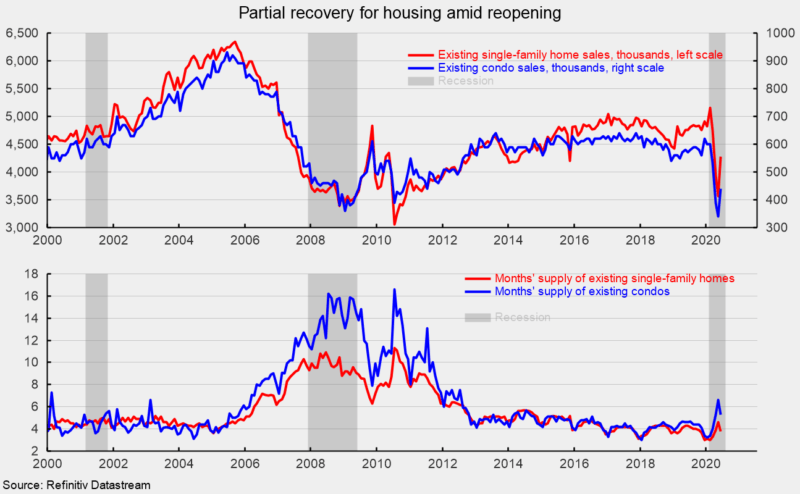Existing-Home Sales Rebound in June; Inventory Remains Tight
Sales of existing homes jumped 20.7 percent in June to a 4.72 million seasonally adjusted annual rate. Sales are still down 11.3 percent from a year ago and below the 5 to 6 million range they had been in since 2015.
Sales were up in all four regions in June: sales were up 31.9 percent in the West but are still down 13.6 percent from the year-ago level; sales rose 26.0 percent in the South, the largest region by volume, leaving that region’s sales rate 4.0 percent below the year-ago pace; sales gained 11.1 percent for the month in the Midwest and are 13.4 percent below the June 2019 rate; and sales were up 4.3 in the Northeast, leaving sales 27.9 percent below year-ago levels.
Sales in the market for existing single-family homes, which account for around 90 percent of total existing-home sales, rose 19.9 percent in June, coming in at a 4.28 million seasonally adjusted annual rate (see top chart). From a year ago, sales are off 9.9 percent. The June pace is about in line with the dip in early 2014 but below the range of 4.4 million to 5 million since early 2015 (see top chart).
By region, sales for existing single-family homes followed the same pattern as total existing homes: sales were up 30.8 percent in the West but are still down 12.4 percent from the year-ago level; sales rose 24.2 percent in the South, leaving that region’s sales rate 2.5 percent below the year-ago pace; sales gained 11.7 percent for the month in the Midwest but are 12.5 percent below the June 2019 rate; and sales were up 4.9 percent in the Northeast, leaving sales 25.9 percent below year-ago levels.
Condo and co-op sales posted a 29.4 percent surge for the month, but still leaving sales 22.8 percent behind the June 2019 pace. Sales came in at a 440,000 pace for the month versus 340,000 in May. Sales of condos and co-ops are only slightly ahead of the lows from the 2008-2009 recession (see top chart).
Total inventory of existing homes for sale rose 1.3 percent to 1.57 million in June, pushing the months’ supply (inventory times 12 divided by the annual selling rate) to 4.0 from 4.8 in May. For the single-family segment, the months’ supply also fell, to 3.8 from 4.6 while the condo and co-op months’ supply fell to 5.3 from 6.6. Months supply for the single-family segment is very low by historical comparison (see bottom chart).
Though mortgage rates are hitting record-low levels, unemployment has surged and the outlook remains highly uncertain, suggesting lending may be somewhat restrained. Furthermore, resurging COVID-19 cases and deaths may discourage buyers and sellers. Conversely, there are anecdotal stories of urban dwellers seeking temporary and permanent housing alternatives. The main risks on the horizon continue to be uncertainty surrounding COVID-19. Whether consumer and business behavior are significantly and permanently altered is unknown as are future government policies to deal with the ongoing pandemic.






